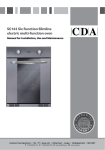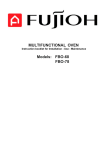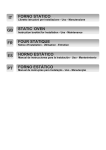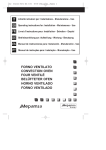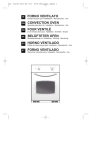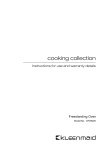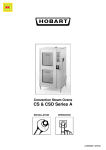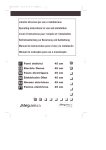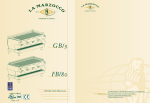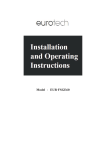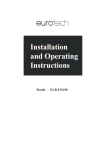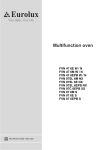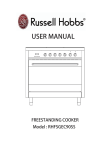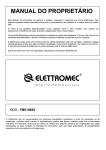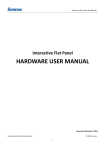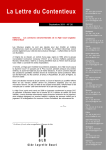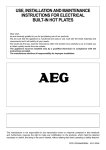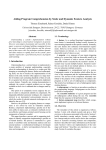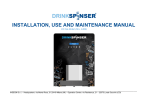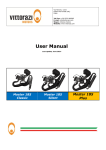Download User manual
Transcript
228 06-05-2003 14:33 GB Pagina 1 CONVECTION OVEN WITH CLEANING BY PYROLYSIS Operating instructions for: Installation - Maintenance - Use 228 06-05-2003 14:33 Pagina 2 228 06-05-2003 14:33 Pagina 3 Before leaving the factory, this appliance was tested and regulated by expert and skilled personnel to give the best operating results. Any repair or regulation that may subsequently be necessary must be carried out with the greatest care and attention. For this reason, we recommend you always contact the Dealer you bought the appliance from or our nearest Service Centre, specifying the type of problem and the model of your appliance. Please remember as well that the original spare parts are available only from our Technical Service Centres. Do not leave the packaging unguarded, both for the safety of children and for the protection of the environment, but dispose of it in a centre for differentiated waste. The symbol on the product or on the packaging means that the product must not be considered as normal household refuse, but must be taken to the appropriate collection point for the recycling of electric and electronic equipment. The appropriate disposal of this product helps avoid potential negative consequences on the environment and for health, which could be caused by inappropriate disposal of the product. For more detailed information on the recycling of this product, please contact your municipal offices, the local waste disposal service or the store where the product was purchased. CONTENTS General warnings pag. 4 Notes for the installation 5-6 Instructions for use 7-11 Instructions for cooking 12-15 Cleaning and maintenance 16-19 Furniture and technical data 20-21 3 228 06-05-2003 14:33 Pagina 21 GENERAL WARNINGS Dear Customer, Thank you for choosing our product. This appliance is easy to use; read this handbook carefully before installing and using it, however. You will find the correct indications for the best installation, use and maintenance of the product. • This product is for cooking and heating food. Do not use it for other purposes. • Very important: keep this instruction booklet with the appliance in case you pass it on to someone else. • This appliance is designed for non professional use by private individuals at home. It must be used by conscious adults, do not allow children to play with it. The front accessible parts of the equipment could overheat during use. • Supervise children and non self-sufficient people when it is being used so that they do not touch hot surfaces and are not near the appliance while it is in use. • Don’t touch the heating elements inside the oven. • The product installation must be performed by competent and qualified installers who are aware of the installation regulations in force. • Before maintenance or cleaning disconnect the appliance from the mains and wait for it to cool down. • The user must not change the appliance supply cable. For replacement contact only a qualified engineer. • Never line the oven with aluminium sheets as the slots preset for keeping fast the thermic exchange may clog, thus damaging the enamel. • WARNING: accessible parts may become hot during use. Young children should be kept away. • For any repairs always contact an authorised Technical Customer Service Centre and ask for original spare parts. Repairs by untrained people can lead to damage. 4 228 06-05-2003 14:33 Pagina 22 NOTES FOR THE INSTALLATION ELECTRICAL CONNECTION The appliances are provided with a three-pole feeding cable and work with alternate current and single-phase voltage indicated on the “rating plate of the product “report at the end of the instruction manual and on the product. The grounding conductor of the cable is marked with the colours yellow/green. CONNECTION OF THE FEEDING CABLE TO THE MAINS Connect the feeding cable of the oven to a plug suitable for the load indicated on the "rating plate of the product". In case of a direct connection to the mains (cable without plug), it is necessary to insert a suitable omnipolar switch before the appliance, with minimum opening between contacts of 3 mm (the grounding wire should not be interrupted by the switch). Before connecting to the mains, make sure that: • the electrical counter, the safety valve, the feeding line and the socket are adequate to withstand the maximum load required (see rating plate). • the supply system is regularly grounded, according to the regulations in force. • the socket or the omnipolar switch can easily be reached after the installation of the oven • after carrying out the connection to the mains, check that the supplying cable does not come into contact with parts subject to heating. • never use reductions, shunts, adaptors which can cause overheating or burning. The manufacturer is not liable for any direct or indirect damage caused by faulty installation or connection. It is therefore necessary that all installation and connection operations are carried out by qualified personnel complying with the local and general regulations in force. This appliance complies with the following Directives: - 2006/95/EC (low voltage equipment) 2004/108/EC (electromagnetic compatibility) 89/109/EC (articles intended to come into contact with foodstuffs) 2002/96/EC (WEEE). 2005/32/CE (EuP). 5 228 06-05-2003 14:33 Pagina 23 NOTES FOR THE INSTALLATION INSERTION AND ASSEMBLY Insert the oven into the opening of the furniture, resting it on the base and pushing it as far as the ledge of the side stanchions against the shoulder of the piece of furniture. For the dimensions of the oven see furniture and technical data. Open the door and fix the oven with four wood screws to be screwed up through the holes in the side stanchions of the oven. Pay attention to fix the oven in an absolutely firm way, as above indicated, and to insulate the electrical elements in order to avoid an eventual contact with metallic parts . The sides and the base surface where the oven is to be installed should be milled as shown in to allow a safe air intake and a free air circulation around the oven, thus granting its good operation and avoiding damages to the furniture. Moreover, the bonding agent joining the rolled sections to the piece of furniture has to stand temperatures no lower than 90°C to avoid deformations and coating disjunction. In case a plane is inserted, the electrical connection of the plane and that of the oven should be carried out separately, both for electrical reasons and to facilitate the frontal extractability of the oven. Once the electrical connection has been carried out, apply voltage to the oven only after installing it. Before using the oven, we suggest to: • remove the special film covering the oven door glass (when provided) • heat the empty oven at max. temperature for 45 minutes (to remove unpleasant smell and smoke caused by working residues and by the thermal insulation) • carefully clean inside the oven with soapy water and rinse it . IMPORTANT: When running, the front side of the appliance gets quite hot. See that children do not get near the oven. 6 228 06-05-2003 14:33 Pagina 24 INSTRUCTIONS FOR USE The selector A and thermostat B are used to select the various oven functions and to choose the cooking temperatures best corresponding to the food to be cooked. During oven operation the lamp will always remain on. 0 0 50 A Max 100 B 250 200 150 The lamp of the oven is on, with no heating elements operated (electrical resistances). DEFROSTING The motor-fan is operated; by stirring the cold air inside the oven, it favours a quick defrosting of the frozen aliments. No heating elements is operated. TRADITIONAL COOKINGS Upper and lower heating elements operated; temperature adjustable from 50°C to MAX on the thermostat. CONVECTION COOKINGS Upper and lower heating elements and the motor-fan operated; temperature adjustable from 50°C to MAX on the thermostat. GRILL COOKINGS Grill element operated; turn the thermostat to position 250°C. Cut in the grill element and the motor-fan.Turn the thermostat to position 250°C. The oven door must be closed for all cooking methods Heating elements for automatic cleaning inserted. See instructions in relevant paragraph 7 228 06-05-2003 14:33 Pagina 25 INSTRUCTIONS FOR USE PROGRAMMING THE OVEN The figure shows the keys, the pilot lights for all the functions and the programmer display. (1) Setting and displaying the minute counter - Timer (2) Setting and displaying the cooking time - Timer (3) Setting and displaying the end of the cooking time (4) Manual operation (5) Setting the times Decrease (6) Setting the times - Increase A 1 B 2 3 4 5 6 Indicator Lights for the Time Functions When the indicator lights are on the appliance is operating, as follows. General operation A U T O Automatic programme Minute minder Setting the Timer When the oven is installed and the power supply is switched on, the display flashes and shows 0.00. To set the time of day Press keys (1) and (2) at the same, and set the actual time, by pressing keys (-) and (+) within 4 seconds. The oven remains in manual operation and can be used without any programming. Important Information • Between 22.00 hrs and 6.00 hrs the display intensity is automatically dimmed. • If the acoustic signal is not disconnected (as per subsequent instructions), it cuts off after 2 minutes. 8 228 06-05-2003 14:33 Pagina 26 INSTRUCTIONS FOR USE • Any programming described below is activated after approximately 4 seconds from the presetting. • 23 hrs and 59 minutes is the maximum programmed time. Any and all programmed settings are erased when there is a power cut or supply failure. When power is restored the display flashes and shows 0.00. To reset the programmer set both the actual time and the programme again. Automatic Operation The oven can be programmed to switch on and off automatically. To do this proceed as follows: 1. Select the required cooking function and temperature using the function selector and the thermostat dial. 2. Press key (2) and set the cooking time by pressing keys (-) and (+) within the next 4 seconds 3. Press key (3) and set the end of the cooking time in the same way. The actual time reappears and pilot light (AUTO) remains ON, when the cooking process starts, pilot light (A) will remain on. The cooking time left can be controlled by pressing key (2), or the time can be changed by repeating the same procedure. Reset the cooking time to 0.00 to erase the preset programme, and when the actual time reappears, press key (4) to reset the manual function. Once the cooking process is over the acoustic signal goes off and the oven is automatically switched off. Press one of the keys from (1) to (4) to return the programmer to the manual function. Semi-automatic Operation The oven can be programmed to switch off automatically. To do this proceed as follows: 1. Select the required function and temperature using the cooking function selector and the thermostat dial. 2. Press key (2) and set the cooking time by pressing keys (-) and (+) within the next 4 seconds. The actual time reappears and pilot lights (A) and (AUTO) remain ON. The cooking time left can be checked by pressing key (2), or the time can be changed by repeating the same procedure. To erase the pre-set programme, reset the cooking time to 0.00, when the actual time reappears, press key (4) to reset to manual function. Once the cooking programme is complete, the acoustic signal will sound and the oven is automatically switched off. Press one of the keys from (1) to (4) to switch off the acoustic signal. Press key (4) to return the programmer to the manual function. 9 228 06-05-2003 14:33 Pagina 27 INSTRUCTIONS FOR USE Minute minder When this device is used as a simple minute minder, press key (1) and programme the required time by pressing keys (-) and (+) within the next 4 seconds: the actual time reappears and the symbol (B) is activated. Press one of the keys from 1 to 4 to disconnect the acoustic signaller. Also symbol (B) is deactivated. Manual Operation The oven may be used manually without any programming. Press key (4) for the manual operation (“AUTO” pilot light off). SAFETY LOCK FOR CHILDREN The programmer is provided with a safety lock which stops the cooking programming and consequently the oven operation; Lock running: - press both switches (1) (2) at same time for about 8 seconds - the display shows “ON”; release the switches - press switch (+); the display shows “OF” and the symbol “..key..” Now the safety lock starts running and after about 5 seconds the display shows the current time and the symbol “..key..”. Lock deactivation: - press both switches (1) (2) at same time for about 8 seconds - the display shows “OF”; release the switches - press switch (+); the display shows “ON” Now the safety lock is deactivated and after about 5 seconds the display shows the current time. 10 228 06-05-2003 14:33 Pagina 28 INSTRUCTIONS FOR USE PILOT LIGHT OF THE THERMOSTAT (°C) It comes on any time the thermostat settles the cooking temperature inside the oven and it is switched off when the oven reaches the preset temperature. PILOT LIGHT FOR THE OPERATION (~) It signals that the appliance is powered and stays on in all working positions. DOOR BLOCK WARNING LIGHT This lights up every time the automatic safety door block is activated during cleaning by pyrolysis (See instructions in relevant paragraph). SAFETY THERMOSTAT It cuts out the electric supply for preventing possible overheatings when the appliance is not correctly used. In this case, wait that the oven cools down before using it again. On the other hand, if a fault is present on the appliance’s components, we advise calling the Technical Assistance Service. COOLING MOTOR The equipment comes with a motor for cooling the inside elements. This motor starts automatically when using the oven. The cooling fan will continue to operate until the oven temperature reaches a value similar to the room temperature (to protect internal components, this fan might also start operating when the oven is off, in the case a cooking-top is mounted above it and is in operation). 11 228 06-05-2003 14:33 Pagina 29 INSTRUCTIONS FOR COOKING OVEN COOKINGS For a perfect cooking it is necessary to pre-heat the oven to the preset cooking temperature. Only vary fat meat can be placed into a cold oven. Never use lowedged containers nor trays as baking-pan for roasts, in order to soil the minimum possible the walls of the oven, thus preventing fat splashes, sauce burning and smoke production. Use instead highedged containers, preferably terracotta containers, put on the grate at about half the height of the oven. The table shows some examples of how to set the thermostat and the cooking time. The cooking times vary according to the type of food, its homogeneity and volume. We are sure that, after a few endeavours, the experience will suggest possible variations to the values shown on the table. Practical hints to save energy The oven can be switched off some minutes before cooking end; the residual temperature is enough to complete cooking. Open the oven door only when it is absolutely necessary; to check the cooking phase, look through the glass (the oven lamp is always on). Pieces of general advice The oven offers various kinds of heating: • the traditional heating for the cooking of special roasts • the ventilated heating for the cooking of cakes, biscuits and similar. If the ventilated heating is chosen, it is recommended to take advantage of it for cooking of roasts on more shelves or for the preparation of complete menus, with time and energy economy. Ventilated heating By this function a continuous circulation of warm air is created, fit for the cooking on more shelves. The temperature are inferior to the traditional ones. Traditional heating It is especially suitable for the cooking of furred and feathered game and as well as for the cooking of bread and sponge cakes. It is advisable to insert the aliments to be cooked into the oven when this is reached the cooking temperature, that is to say when the yellow warning light extinguishes. 12 228 06-05-2003 14:33 Pagina 30 INSTRUCTIONS FOR COOKING GRILL COOKINGS To cook on the grill or on the grate, pre-heat the oven for about 5 minutes. During grill operation the heat comes from above; it is based on the infrared radiation and is fit for low thickness meat and for toasts. The meat and the fish to be grilled are to be slightly oiled and always placed on the grate; this is to be arranged on the nearest or on the farthest guide from the grill element, according to the thickness of the meat to be cooked. The table shows some examples of cooking times and food positions. The cooking times vary according to the type of food, its homogeneity and volume. COOKING OF THE PASTRY The air circulation of the oven assures an instantaneous and uniform heat distribution. The forewarming of the oven is no longer necessary. However for specially delicate pastry the oven can be forewarmed. More trays can be inserted into the oven together with the pastries, taking care not to use the first grid starting from above. Together with the pastry, also other aliments of different nature can be cooked at the same time (fish, meat, etc.) without any transmission of smells and savours.These multiple cookings can be carried out only provided that, although having different cooking times, the aliments to be cooked have the same cooking temperature. GRATINATING By this term is meant the surface alteration of an aliment, often forecooked, when, after being introduced into the oven, it takes a golden-brown and crisp aspect. “Gnocchi alla romana”, polenta pasticciata”, rice, lasagnas, noodles and vegetables dressed with bechamel are typical preparation for this type of cooking. DEFROSTING The defrosting takes place in the same way as at room temperature, but with the advantage that is much more rapid. The ten hours of the refrigerator are reduced to an hour for a kilogram of meat. Put the meat envelope into its packing on a dish. Introduce it into the oven. 13 228 06-05-2003 14:33 Pagina 31 INSTRUCTIONS FOR COOKING COOKING TIMES The table shows some examples for the adjustment of the thermostat and of the cooking time. The cooking times can vary according to the type of food, its homogeneity and volume. We are sure that, after a few endeavours, the experience will suggest possible variations to the values shown on the table. REMARK: • For the beef, veal, porc and turkey roasts, with bones or rolled, add about 20 minutes to the times shown in the table. • The indication suggested on the table for the use of the steps is the preferential one in the case of the cooking of several aliments. • The times indicated in the table refer to the cooking of one aliment only; for more than one aliment, the cooking times should be increased by 5 - 10 minutes. 14 228 06-05-2003 14:33 Pagina 32 Table of cooking times Guide No. Nature of food Oven Temp. °C 4 3 2 1 Time Minutes FOOD 2 2 1 2 1 1 220-250 225-250 210-250 225-250 200-225 180-200 Base only “ “ 2 2 2 2 1 2 2 2 160-200 170-180 170-180 200 215-230 215 200-215 140 215-230 250 230 Long-cooking roast Quick cooking roast Fowl (Guinea hen, duck, etc) Poultry Game Fish dep. on qty 50-60 150-180 50-60 dep. on qty 20-25 PASTRIES Christmas cake Plum-cake Orange cake Savoy biscuits Brioches Puff pastry Sponge cake Meringues Cream puff pastry Fruit cake (unleavened pastry) Fruit cake (leavened pastry) 60-70 90-100 80-100 40-45 35-40 30-40 30-35 60-80 30 30-35 20-30 Table of grill cooking times Qty.Kg Guide No. 4 3 2 1 Nature of food Veal cutlet Lam cutlet Liver Chopped meat roulades Veal heart Roast in the net Half-chicken Fish fillet Stuffed tomatoes 1 “ “ “ “ “ - 3 “ “ “ “ “ “ “ “ 15 Temp.°C 250 “ “ “ “ “ “ “ “ Pre-heat time in minutes 5 “ “ “ “ “ “ “ “ Time in min. 8-10 12-15 10-12 12-15 12-15 20-25 20-25 12-15 10-12 228 06-05-2003 14:33 Pagina 33 CLEANING AND MAINTENANCE Caution: before any operation, disconnect electrically the oven. General cleaning To keep the characteristics of brightness of the enamelled parts for a long time it is necessary to clean the oven after each cooking. Once the oven is cold, you will be able to easily remove the fat deposits by means of a sponge or a cloth damp with warm soapy water and eventually a detergent to be found on the market. Never use abrasive cloths or sponges, that could irreparably damage the enamel. On white ovens even the parts of the dash board such as handgrip and knob have to be cleaned each time because they may become yellow due to the emissions of fat vapours. After the use, rinse thoroughly with water the parts in stainless steel and dry them with a soft cloth or with a buckskin. In case of persistent stain, use the normal non-abrasive cleaning agents or one of the specific products for stainless steel or some warm vinegar. Clean the door glass only with warm water, avoiding the use of rough cloths. "Do not use jet of steam for cleaning." Cleaning the oven door Unhooking the door 1. Set the oven's door wide open. 2. Lift the hinge jumpers by your thumb and index fingers, then turn them fully outwards to the end of stroke (Fig.A). 3. Turn the door towards the closure position and lay it on the jumpers: in this way the hinge's spring results as blocked. By fully closing the door the hinges are unhooked from the connection slits which are integral with the oven's muffle (sequence 1,2,3 of fig.B). 1 16 228 06-05-2003 14:33 Pagina 34 CLEANING AND MAINTENANCE Hooking the door 1. Insert the door by hooking the hinges to the connection slits set on the muffle front. 2. Fully open the door when inserted, then push and turn the cross connections which fasten the springs full scale in the oven direction. 3. Close the door and check its correct operation. Replacing the oven bulb Once the oven has been electrically disconnected, unscrew the glass protection cap and the bulb, replacing it with another one suitable for high temperatures (500°C/E14 ). Reassemble the glass cap and reconnect the oven. 17 228 06-05-2003 14:33 Pagina 35 CLEANING AND MAINTENANCE INSTRUCTIONS FOR AUTOMATIC CLEANING BY PYROLYSIS The oven is provided with an automatic cleaning function which, using the high temperature reached, burns and decomposes any cooking residues. The instructions to operate this function, particularly recommended after cooking fatty food, are given hereunder. WARNING: DURING AUTOMATIC CLEANING, THE FRONT SURFACES OF THE OVEN CAN BECOME VERY HOT. KEEP CHILDREN WELL AWAY DURING THIS TIME. THE AUTOMATIC CLEANING CYCLE CANNOT BE ACTIVATED WITH THE TIMER IN THE MANUAL POSITION. DURING THE CLEANING CYCLE, THE OVEL LIGHT REMAINS OFF. Before starting the cleaning cycle, performe the following operations: - eliminate any residue with a normal wet sponge (without using detergents or acid commonly on the market) while the oven is warm. - remove all accessories (shelves, dishes, etc. can be washed by hand or in the dishwasher) which are not made to resist the high temperature reached during the cycle and which could hinder diffusion of heat to all oven walls. - do not hang heat-sensitive or infiammable objects on the oven door handle (such as cloths, rags, etc.) - ensure that the oven door is closed properly. - place cooking thermostat on “0”. Start cleaning cycle: - close door - place function switch on the “cleaning” position. The programmer automatically sets the min. cleaning time of 1 hour and 30 minutes. It is possible to increase such time up to 3 hours by pressing the button (+) depending on the actual oven dirt level. Further information: - For safety reasons, the oven is provided with a door blocking device which operates during the cleaning cycle (warning light with “key” symbol), before the internal temperature reaches 350° C. Besides this, if the door is opened before the blocking device comes into operation, another device is activated which disconnects the heating elements until the door is closed again. - During the cleaning cycle, when the internal temperature reaches approx. 500° C, flashes of light might be seen which are due to carbonisation of the dirt in contact with the heating elements. This is a natural phenomenon and is not an indication of any anomaly whatsoever. - During the cleaning cycle, smoke may come out of the front slots; in this case too the phenomenon is a natural consequence of the dirt burning inside (we recommend airing the room). 18 228 06-05-2003 14:33 Pagina 36 CLEANING AND MAINTENANCE End of cleaning cycle: - Once the set time is over the oven is automatically switched-off without the intervention of the acoustic signal, and the display winks on 0.00. - Please reset the function selector in “0” position. - The oven door can only be reopened when the internal temperature has reached less than 350° C (the “key” warning light switches off). - The oven walls will now covered with a white powder which can easily be removed with a wet sponge after the oven has cooled completely. - The cooling fan will continue to operate until the oven temperature reaches a value similar to the room temperature (to protect internal components, this fan might also start operating when the oven is off, in the case a cooking-top is mounted above it and is in operation). 19 228 06-05-2003 14:35 Pagina 99 Furniture and technical data 100 450 580 560 450 100 560 558 580 560 450 596 400 560 574 530 598 23 20 60 228 06-05-2003 14:35 Pagina 100 Working volume of the oven 55 lt Electrical features Grill resistance Upper resistance Lower resistance Lighting bulb Motorventilator Cooling fan 2000 700 1100 25 35 35 W W W W W W 21 228 06-05-2003 14:35 Pagina 104 Rating plate of the product Dis. Cod. Rev. DA S506_355 000000000000 0 del 10/09






















